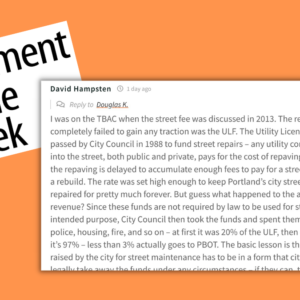We’re always glad to see the subject of a story show up in a comment thread. When the subject of a story happens to be a political candidate on her way to hundreds of thousands of ballots in a few months, that’s even better.
Thursday morning, Portland City Council candidate Chloe Eudaly jumped (politely but authoritatively) into a discussion about her positions on transportation and housing. It was taking place beneath our post about her late surge to make the November runoff against sitting council member and Transportation Commissioner Steve Novick.
Her transportation thoughts are, she admitted, weak on detail so far. But they’re strong on credibility — among other first-rate literary references, they included a story about her time biking around Amsterdam with one of the best-known writers about urban bicycling, “Dishwasher” Pete Jordan.
Here’s what Eudaly wrote, partly in response to Terry Dublinski-Milton’s observation that she hadn’t returned a Bike Walk Vote questionnaire:
Hey Everybody, I am very sorry I didn’t get the questionnaire back before the primary. This has been a hectic four months for me — working, parenting and campaigning — and I’m afraid because there was no deadline attached it kept getting buried by more time sensitive stuff. I will submit the questionnaire soon, in the meantime I can tell you a bit about my relationship to bikes, cars, and public transportation…
I lived car free for many years in my 20s and prioritized living within biking/walking distance to work. However, two things have changed in my life since I hit 30 — I had a kid who happens to have a severe physical disability and uses a wheelchair (he’s now 15) and we’ve been pushed out of the central city by rising rents in the past decade. To complicate matters, parents of kids with disabilities don’t always get to choose where their children attend school, so while we have always lived within walking distance of our neighborhood schools (currently Woodlawn/Jefferson) he was never able to attend them. There is no safe way for me to transport my son by bicycle, nor is there enough time in the day for us to exclusively use public transportation (I work full time and am a single parent), especially considering we sometimes have to wait for 2-3 buses just to board if the wheelchair spot is occupied. If you have kids, please imagine a situation where no one else has a vehicle that could accommodate your kid, you can’t ask a friend or neighbor to grab them in a pinch, and they cannot get themselves to or from home — this is my situation. So, I own a wheelchair van and a bicycle. I drive about half as much as the average person, and I rent more fuel efficient cars for my very occasional road trips, but I am dependent on the van until or unless I can create a life for us where home/work/school/medical services are close-in and reliabely accessible by public transportation (which probably means living near a Max or streetcar line).
I do enjoy riding my bike (a Linus Dutchi I bought from my friend Kim at North Portland Bicycle Works — one of the few off the shelf bikes I can ride as I’m just a little over 5′ tall), although I feel somewhat ruined for cycling in Portland after spending a few days tooling around Amsterdam on bikes with my friend Pete Jordan, who’s the author of In the City of Bikes: The Story of the Amsterdam Cyclist. Pete, a former Portlander and avid cyclist, planned to spend a school year studying urban planning in Amsterdam in 2002 and he never left! I’m looking forward to talking to him about his take on how Portland is measuring up on bicycle transportation.
Advertisement
I got interested in urban planning, humane architecture, and transportation issues as a teenager when I stumbled upon books by Bernard Rudofsky (Streets for People) and Christopher Alexander (A Pattern Language). I’m probably not going to have every answer you want right now because I’m someone who really needs to dig into issues and get a broad grasp before I start asserting opinions and suggesting policy solutions, but this is what I can say for certainty right now: Safe and accessible streets for pedestrians and cyclists are a priority for me and we need to be creating them across the city. I’m interested in what Bike Portland has to say about equity across our neighborhoods in regards to things like sidewalks, crosswalks, and bicycle infrastructure. When people cannot safely walk in their neighborhoods and many people with mobility challenges (growing in numbers with our aging population) are virtually housebound due to living in inaccessible neighborhoods, it’s hard to get them excited about spending $$$ on bike paths. I’d personally love to see continued and increased collaboration between bicycle advocates, disability advocates, and neighborhoods around these issues.
I’m also interested in incentivizing living close to home (some cities have special home loan programs for people who commit to this), improving our public transportation system including making it more affordable for low income riders like Seattle is doing, preserving and increasing housing in the central city for low income and moderate income earners in order to reduce commuting among other things, and creating more events along the lines of Sunday Parkways where we at least temporarily take back our streets for other purposes. Since most of our cities were designed around the automobile, it’s hard for a lot of people to conceive of why we’d want it any other way, we need to start showing them. xc
It’s worth noting that Novick would have had a harder time biking around Amsterdam with Jordan, because of his own physical disabilities. He tried to ride a bike while growing up outside Eugene but (as he put it once) “kept falling off” and hasn’t biked himself since. That hasn’t stopped him from gradually being a solidly pro-biking commissioner over the last four years, notably by choosing to take huge heat over the walking and biking improvements he fought to keep in the gas tax package.
We hope Eudaly will fill in her own policy perspectives on the ways biking can help create a less car-dependent city for everyone — and that the next five months will include some healthy debate between them over how to make biking improve the lives of more Portlanders, whether or not they personally can ride a bicycle.
Eudaly’s personal history sound like a potentially great foundation.
— Michael Andersen, (503) 333-7824 – michael@bikeportland.org
Our work is supported by subscribers. Please become one today.






Thanks for reading.
BikePortland has served this community with independent community journalism since 2005. We rely on subscriptions from readers like you to survive. Your financial support is vital in keeping this valuable resource alive and well.
Please subscribe today to strengthen and expand our work.
I am glad to see CotW returning. And enjoyed Chloe’s comment and interesting biography. As a bike trailer enthusiast I’ve long wondered how folks who are in a situation like hers feel about those that are designed for transporting otherwise wheel chair bound children or adults. Several companies make them, and they show up on the used market from time to time which suggests to me that they must serve some purpose.
Blue Sky Cycle Carts here in Oregon makes one:
http://www.blueskycyclecarts.com/BSkyHandicap.htm
as does Cycletote in Ft. Collins:
https://cycletote.com/trailers/special-needs-trailers/
(I have this one. Getting in and out of it for an able bodied adult seems like a challenge, but once you’ve got that part figured out I think the hauling should be pretty doable)
I’d love to have access to a bike trailer to take my kid on rides through parks and accessible nature areas but I wouldn’t dream of sharing the road with Henry hitched to the back of my bike. Because of his disability he has low tone and thin bones and is much more vulnerable to injury than the average kid, from whiplash to broken bones. If I were seriously injured, he would have no way to call for help or communicate. I considered getting a cargo bike when he was younger but couldn’t solve the problem of not having a chair on the other end!
There’s also the issue of needing to get to him quickly in the event of an urgent medical situation, which means I need to have pretty ready access to a wheelchair accessible vehicle. Navigating the world with a family member with severe disabilities requires a level of level of planning, foresight, preparedness, and caution that’s hard to convey to people who have never had the experience. That said, as I mentioned above, if we had ideal proximity of home/work/school/medical services we could dramatically reduce our dependence on our van.
People with significant disabilities have greatly diminished outcomes in school, work, health, etc. There are a variety of reasons for this but the difficulty of simply navigating the outside world is huge. I have a brilliant friend who works in disability advocacy, uses a power chair, and used to live in Portland. She was asked to speak at a college in Vancouver, WA. There was no way (too many physical obstacles) for her to get from where she lived to the campus by public transportation. Her other option was to take an expensive cab ride which would have eaten up most of her honorarium. I was able to drive her there and back, but imagine having to face a quandary like this every day.
I’m going into an amount of detail here that may be boring to some but I’m hoping to help build some understanding between the bike community and the disability community. People with disabilities have historically been excluded from much of public life and struggle with so many basic things the rest of us take for granted. Many non-disabled people think that the passage of the ADA 20+ years ago somehow magically solved all of our problems. That is sadly not the case.
I hadn’t clicked through the links before responding to your comment. These carts would be great for a spin around the neighborhood or through the park but are useless as transportation options for people who use wheelchairs because they cannot accommodate a chair, so the person would be left sitting in the cart. There are wheelchair carts made for bikes, but as noted above they’re just not safe enough for me to use to transport my son on city streets, not to mention the fact that I’d be biking around with an extra 150+ lbs which would limit where and how far we could go. There are also bike/wheelchair contraptions but the wear and tear on the wheelchair would be tremendous and again, just not safe enough.
The best solution for decreasing dependency on vehicles for people with mobility challenges are: affordable close-in housing and accessible, reliable and abundant public transportation.
aside: 9watts is from the future, where bikes have 75% mode share — so you have to see what he writes through that lens or it might sound totally nuts 😉
I appreciate your sharing these insights and agree that it’s very difficult to use such a rig for other than recreational trips or those that start and end with a chair (even then, you’re at some risk of excessive difficulty if something goes wrong, which is often more likely with a more minimalist vehicle.) Short trips on quiet streets or protected bikeways with lots of alternatives and/or support available and an electric motor could allow for more people with disabilities to have more independence with less expense (of energy, money, space, etc.) I think a good bike network could do that for us, though at the expense of auto connectivity and parking (or else we better plant a money tree.) Your son may or may not be able to ride alone on such a network even with a specialized chair/trike, but I’m guessing those who can somehow manage to get rolling at 8-20mph on 3 or even 4 wheels would benefit from the fresh air, independence, and exercise (even with a motor.) While some people will still have a really good reason to use a van, they’ll generally need to go the long way around — which isn’t a big deal with such a big machine, especially when you compare that inconvenience to what we’re losing by letting everyone drive cars fast on every street.
Don’t forget to see what these issues look like on the westside terrain, where limited connectivity and narrow ROW means wheelchair users are often left using substandard painted bike lanes (or none) on 35+mph arterial streets. The cost of a van with lift vs a special trike might make a beatup old van a better deal in the short term, but I would argue that scaring people into energy-intensive transportation is a worse deal than just making a civil streetscape for everybody.
I think bikes are a good bridge between the city we have and the one we want and I find it encouraging that you’ve given some thought to these issues. Thank you.
Hi eric,
Please don’t refer to someone else’s perspective as “nuts.” That’s not a very nice thing to say. 9watts is a super neat and thoughtful guy with lots of experience living car-free. He’s not just some random commenter, he’s a member of our community whose input here I really value — just like yours.
Thanks!
Hi Jonathan. Sorry if that didn’t come across as intended. I’m sad that you seem to have interpreted it as me saying his perspective wasn’t reasonable. In fact, that’s part of the point I was trying to make.
9watts has clearly given lots of thought toward a sustainable level of energy use (not to mention effort and experience.) This is why I said he is “from the future” (which might be a joke, you never know 😉
So, when someone from the future tells us about a simpler, low-energy way to transport ourselves or families the tendency from today’s perspective is to worry about the risk from all of these smelly, fast, heavy things which are currently roaring along every street in our city. The flawed assumption behind conventional wisdom, of course (or at least it seems obvious to me) is that all of our streets must allow all vehicles to go in one end and out the other at speed. I guess part of my point was that what might seem crazy is just a matter of perspective and assumptions.
I voted for her and like very much the way she thinks and writes. She’s experienced firsthand a lot of the difficulties and frustrations (and then some) so many Portlanders are now facing. Best of luck to her!
Thanks to Chloe for making good use of the opportunity to educate on the challenges that disabled folks face – there is a lot that non disabled people take for granted. Not sure who I’m voting for in November, but how fortunate to live in a town where we have two such progressive and thoughtful candidates for one city council position.
“…When people cannot safely walk in their neighborhoods and many people with mobility challenges (growing in numbers with our aging population) are virtually housebound due to living in inaccessible neighborhoods, it’s hard to get them excited about spending $$$ on bike paths. …” Eudaly
Even in nice, quiet neighborhoods, standard width sidewalks, I believe, aren’t something that provides a great incentive for people to walk from their house to a destination, (store, school, church, etc.), within a mile away.
Examples provided, of high quality pedestrian-bike esplanades within neighborhoods, utilitarian rather than primarily recreational as are the waterfront esplanades, may be something many people could get far more excited about supporting with their dollars, than they can about supporting bike paths.
As wsbob noted, nice quiet neighborhoods and standard width sidewalks often aren’t enough incentive for people to walk to destinations within a mile away. Often the necessary incentive is destinations that are less than 1/4 of a mile away. Allowing neighborhoods to develop so the majority of city residents live closer to the shopping, work, and transit destinations will help increase walking, and probably biking, mode share. Allowing more housing within a 1/4 mile corridor along commercial and transit streets will help those business districts grow and provide more services for those people.